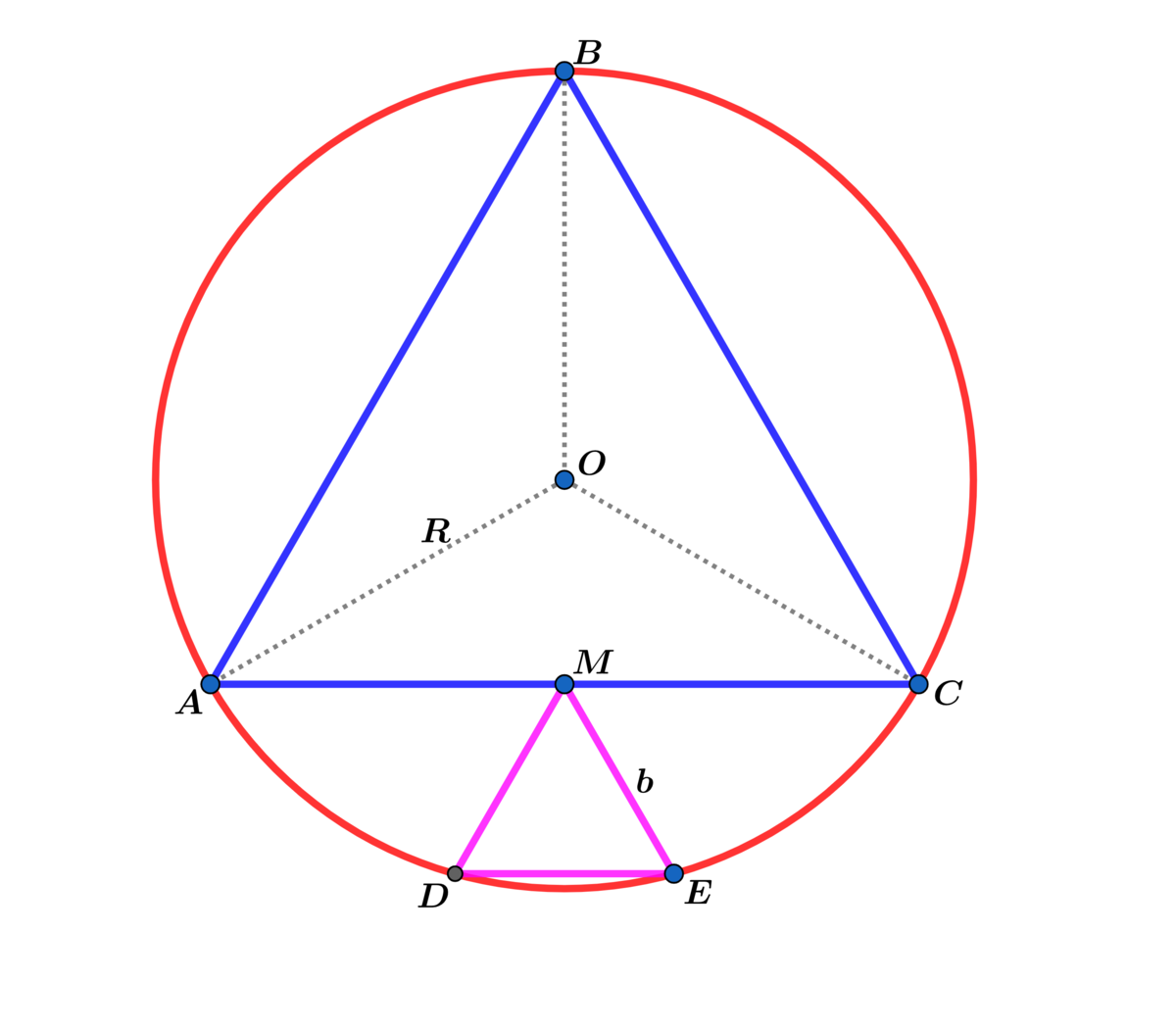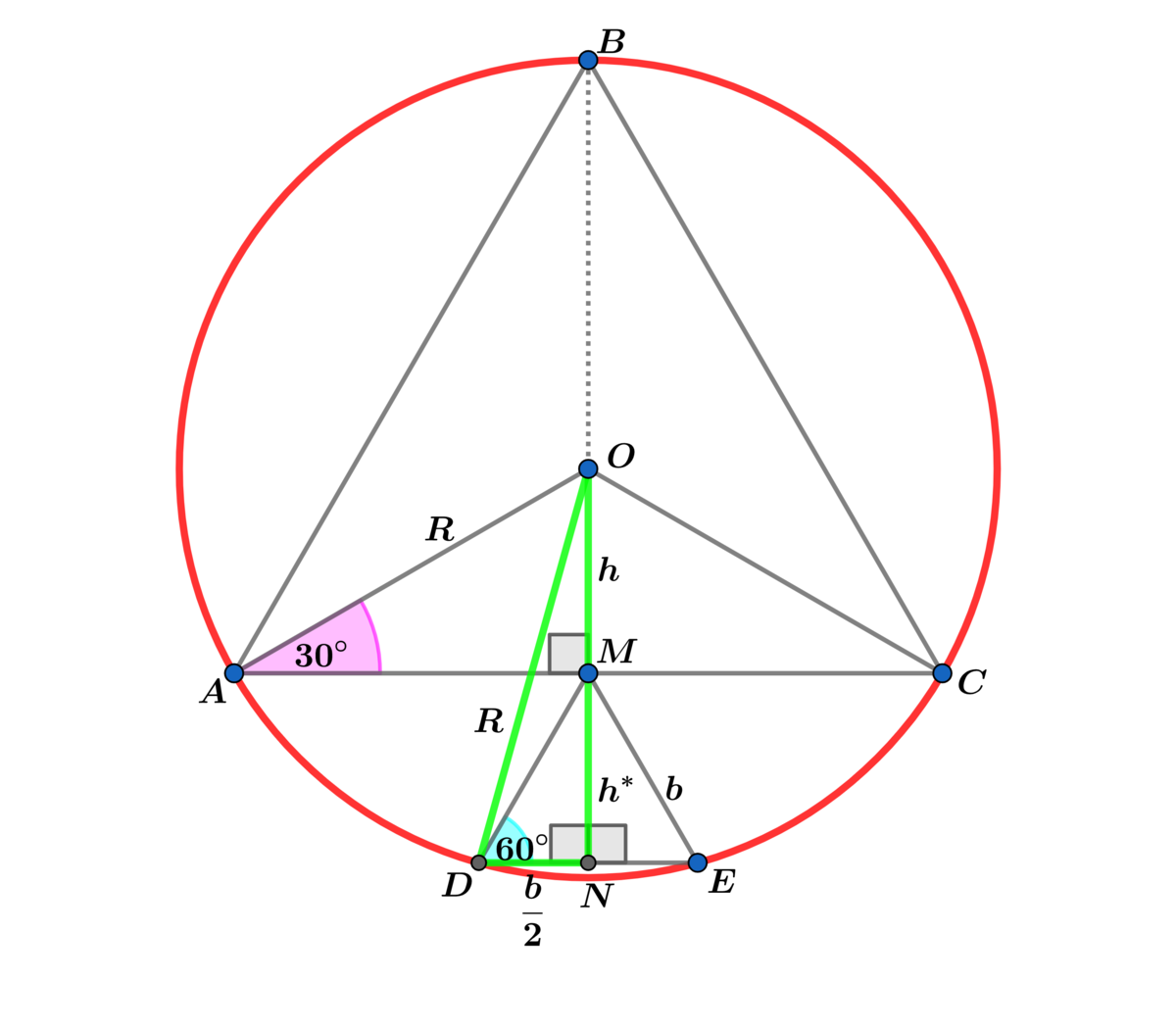Golden Problem!

Equilateral △ A B C is inscribed In the circle above with radius R and Equilateral △ D M E with side length b has vertex M at the midpoint of A C and the other two vertices D and E are on the circle.
If R b = β α ( ϕ − 1 ) , where ϕ is the golden ratio and a and b are coprime positive integers, find α + β .
The answer is 5.
This section requires Javascript.
You are seeing this because something didn't load right. We suggest you, (a) try
refreshing the page, (b) enabling javascript if it is disabled on your browser and,
finally, (c)
loading the
non-javascript version of this page
. We're sorry about the hassle.
2 solutions
Do you need to specify that the triangles are equilateral for this problem, rather than isosceles?
Log in to reply
Yes. In my solution I used the fact the both triangles are equilateral. I used this fact below:

In △ A B C h = R sin ( 3 0 ∘ ) = 2 R and in △ D M E h ∗ = R sin ( 6 0 ∘ ) = 2 3 b
Log in to reply
I saw that, but the original problem states that the two triangles are isosceles which means your solution represents only one specific situation where the isosceles triangles are actually equilateral. If both triangles were isosceles right triangles, for example, the ratio of b/R would actually be 1. I think that you need to clarify that in how you state the original problem.
Log in to reply
@Dan Brabec – I thought I typed Equilateral. I changed it. Thanks!
I think it is worth mentioning what Fukagawa Hidetoshi and Tony Rothman tell us about this problem in their valuable book SACRED MATHEMATICS: Japanese Temple Geometry (problem 6, page 95):
"We know of this problem from the unpublished manuscript Jinbyo Bukkaku Sangakushu , or Collection of Sangaku from the Aida School, written by Aida Yasuaki (1747–1817) at an unknown date. The problem was originally proposed in 1800 by Kobata Atsukuni, a student of the Aida school, and presented on a tablet to the Kanzeondo temple of Toba castle town."
Log in to reply
I don't know of the book, but this is a Japanese Temple Problem.
Log in to reply
Check it out. It is a very interesting reference book for Japanese temple geometry.
Log in to reply
@Thanos Petropoulos – I'll check it out. Thanks!
Let R = 1 and draw O M and O E . Then O E = O A = R = 1 , and by the properties of an equilateral triangle, O M = 2 1 O A = 2 1 R = 2 1 .
Also, ∠ O M E = ∠ O M C + ∠ C M E = 9 0 ° + 6 0 ° = 1 5 0 ° .
By the law of cosines on △ O M E , cos ∠ O M E = 2 ⋅ O M ⋅ M E O M 2 + M E 2 − O E 2 , or cos 1 5 0 ° = 2 ⋅ 2 1 ⋅ b ( 2 1 ) 2 + b 2 − 1 2 , which solves to b = 3 ( 4 5 − 1 ) = 2 3 ( ϕ − 1 ) .
Therefore, α = 3 , β = 2 , and α + β = 5 .
h = 2 R and h ∗ = 2 3 b ⟹ h + h ∗ = O N = 2 3 + 2 R .
Using Pythagorean Theorem on right △ O D N ⟹ ( 2 3 b + 2 R ) 2 + 4 b 2 = R 2 ⟹
( 3 b + R ) 2 + b 2 = 4 R 2 ⟹ 3 b 2 + 2 3 b R + R 2 + b 2 = 4 R 2 ⟹
4 b 2 + 2 3 R − 3 R 2 = 0 ⟹ b = 4 1 5 − 3 R dropping the negative root
⟹ R b = 2 3 ( 2 5 − 1 ) = 2 3 ( ϕ − 1 ) = β α ( ϕ − 1 ) ⟹ α + β = 5 .